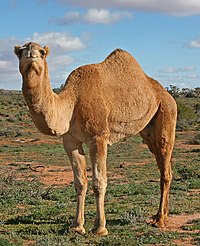
Photo from wikipedia
Lactoferrin is the most dominant protein in milk after casein. This protein plays a crucial role in many biological processes including the regulation of iron metabolism, induction and modulation of… Click to show full abstract
Lactoferrin is the most dominant protein in milk after casein. This protein plays a crucial role in many biological processes including the regulation of iron metabolism, induction and modulation of the immune system, the primary defense against microorganisms, inhibiting lipid peroxidation and presenting antimicrobial activity against various pathogens such as parasites, fungi, bacteria, and viruses. The major antimicrobial effect of lactoferrin is related to its N-terminal tail where different peptides for instance lactoferricin and lactoferrampin which are important for their antimicrobial abilities are present. The growth rate of bacterial cells in camel milk is lower than that of the cow milk due to having more antimicrobial compounds. In this study, we have fused a codon-optimized partial camel lactoferrcin and lactoferrampin DNA sequences in order to construct a fused peptide via a lysine. This chimeric 42-mer peptide consists of complete and partial amino acid sequence of camel lactoferrampin and lactoferricin, respectively. Human embryonic kidney 293 (HEK-293) cells were used for synthesizing this recombinant peptide. Finally, the antibacterial activities of this constructed peptide were investigated under in vitro condition. The result showed that, all construction, cloning and expression processes were successfully performed in HEK-293. One His-tag tail was added to the chimera in order to optimize the isolation and purification processes and also reduce the cost of production. Additionally, His-tag retained the antimicrobial activity of the chimera. The antimicrobial tests showed that the growth rate in the majority of bacterial plant pathogens, including gram negative and positive bacteria, was inhibited by recombinant chimera as the level of MIC values were evaluated between 0.39 and 25.07 μg/ml for different bacterial isolates.
Journal Title: Probiotics and Antimicrobial Proteins
Year Published: 2018
Link to full text (if available)
Share on Social Media: Sign Up to like & get
recommendations!